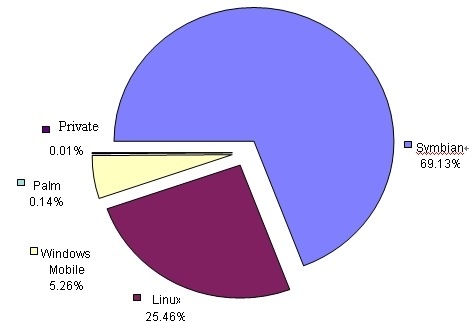China smartphone sales up, but Linux loses share
Nov 19, 2007 — by Eric Brown — from the LinuxDevices Archive — viewsIn China, the world's largest mobile phone market, smartphone sales for Q3 grew 11.3 percent quarter-over-quarter, reports CCID Consulting. However, Linux's share of the market declined, largely due to weakening volumes for Motorola smartphones, the Hong Kong-based market research firm reported.
According to CCID, China's smartphone market grew from 6.1 million handsets in Q2 to 6.4 million sets in Q3, a 5.2 percent increase. Revenue over the same period grew from 14.9 billion yuan to 16.6 billion yuan, an 11.3 percent increase. The firm ascribes the jump to students buying phones during the summer vacation, and to promotions during the Chinese national holiday.

Chinese smartphone operating system market share, Q3 2007
(Source: CCID Consulting)
CCID believes that Linux accounted for 25.46 percent of smartphones in Q3, down from about 30 percent for the year 2006. The firm pins the drop on Motorola, noting, “The market share of Motorola accounts for 70 percent of the total Linux market. Consequently, the market share of Linux operating systems is closely joined with the sales volume of Motorola smart phones.”
 The “Ming” (Click for details) |
In 2006, Motorola's best-selling smartphone was the A1200 or “Ming,” a small touchscreen model with a high-resolution camera, music player, and business card scanner. Wildly successful, the phone sold a million units in Q2, 2006 alone, according to Canalys, a research firm covering the global phone market.
In the U.S., Motorola has been criticized for failing to build upon the success of its popular Razr phone. The company's “Razr2” models are just now reaching market, many years after the Razr's debut, and have met with some criticism for being too derivative of the original Razr's ultra-thin style.
Meanwhile, Windows Mobile-based phones from Motorola, Samsung, Lenovo, and Dopod (HTC) grew 52 percent from the previous quarter, but still only accounted for 5 percent of the market, said CCID. Palm's share dropped over 52 percent from the previous year, reaching a minuscule one tenth of a percent. Symbian OS continued to grow, capturing nearly 70 percent of the market, up from 63.2 percent at year end 2006.
According to the study, smartphones with a screen size larger than 2 inches now make up more than 90 percent of the Chinese market, with sales of 2.4-inch models rising sharply. Beyond 2.4 inches, however, demand has decreased nearly 13 percent, which CCID speculates is due to customers wanting smaller, lighter phones.
This article was originally published on LinuxDevices.com and has been donated to the open source community by QuinStreet Inc. Please visit LinuxToday.com for up-to-date news and articles about Linux and open source.